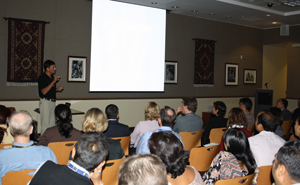Background
The Himalayan mountain range is the most active intra-continental (within a continent) mountain range on Earth. It is also one of the youngest. The Himalayas were not even in existence at the time of the dinosaurs; at that time, India was, like Australia is today, an isolated piece of continent.
About 50 million years ago, India collided with Eurasia (the land mass comprising the continents of Europe and Asia).
India was traveling to the North at a speed of about 10 cm/year (about as fast as fingernails grow) relative to Eurasia.
As India kept moving North, this slow collision between two land masses crumpled the earth's surface, giving rise to the Himalayan mountains, the Tibet plateau, and the Tian Shan mountain range even further North.
As India continues its collision with Eurasia today, though at about a third the speed, the mountain building continues, earthquake by earthquake.
|
Presentations in Nepal
TO geodesy specialist John Galetzka has given many presentations in Nepal about earthquake hazards and safety.
Watch his latest presentation:
"Nepal: Japan-size earthquakes,
Haiti-like infrastructure"

John Galetza speaking at the US Embassy in Nepal - to Nepali government officials as well as nongovernmental organizations (NGO)
|
Research highlights
Video
|
|

